Research Article
DISASTER RISK REDUCTION MANAGEMENT SYSTEM: THE CASE OF A STATE UNIVERSITY IN THE PHILIPPINES
8836
Views & Citations7836
Likes & Shares
The recent outbreak of risk and disaster in the Philippines is alarming. The impacts of such do not only leave many emotional and physical turmoil, but also negative impacts to socio-economic wellbeing to communities and the people. To address this, the country established the National Disaster Risk Reduction and Management Office (NDRRMO) with local arms in every provinces and municipalities in the country which was extended among state universities. This study was conducted with the primary goal to establish empirical data regarding the risk reduction management system of West Visayas State University- Lambunao Campus (WVSU-LC), Philippines to preempt a risk and disaster reduction management plan. Quantitative and qualitative approaches were employed using survey technique and focus group discussion technique respectively. There was a total of 104 respondents in the study, 82 respondents in the first part and 22 respondents for the second part. Data were analyzed using frequency distribution, percentage, mean, and standard deviation for the first part. The responses from the focus group discussion were analyzed thematically and narrative analysis. Man-made and natural disasters like fire, typhoon, and earthquakes were the identified disaster that might threaten the safety and security of the WVSU-LC community. Results revealed that there is no existing risk and disaster reduction management system in the university in terms of disaster prevention and mitigation, disaster preparedness, disaster responsiveness, and disaster rehabilitation. However, the school has high capability in disaster response in terms of facilities and technology, manpower, budgetary requirements, and logistics. Collectively, results from the focus group arrived with the conclusion and recommendation of creating a detailed and effective School Based Risk and Disaster Reduction Management Plan (SBRDRMP). It was also recommended that the plan must focus on disaster prevention dissemination, preparedness, response, and recovery programs.
Keywords: Disaster, Risk, Reduction, Management System, State University in the Philippines
INTRODUCTION
In the past few years, the Philippines particular in Western Visayas Region had been facing tremendous crises due to its vulnerability to series of disasters arising from natural events, like earthquakes, typhoons, climate change, and heavy rains manifesting marginal damages caused by floods, landslides, fire outbreak and the like.
Disasters and risks of all kinds occur when hazards critically affect communities and households and destroy, for the time being or for many years, threaten the livelihood security of their members (Gjerde, 2017). A disaster results from the combination of hazard risk conditions, societal vulnerability, and the limited capacities of households or communities to reduce the potential harmful impact of the hazard (Rufat, et. al., 2015). The acknowledgment of vulnerability as a key component in the risk context has also been accompanied by growing interest in understanding and enhancing the positive capacities of people to cope with the impact of hazards (Comerio, 2014). (Fekete, 2012). Stated that vulnerability is often associated with population and built environment density that corresponds to communities with lower income. (Aldrich, 2013). Added that the existence or absence of appropriate socio-economic and institutional systems to mitigate or respond rapidly to hazards determines a societies or a community’s susceptibility or resilience to the impacts of hazards. In other words, the coping capacities ensured by these systems translate directly into enhanced resilience (Rufat, et. al., 2015).
Disasters have always been a result of human interaction with nature, technology and other living entities. Sometimes unpredictable and sudden, sometimes slow and lingering, various types of disasters continually affect the way in which we live our daily lives (Fekete, et., al., 2010). Human beings as more sophisticated creatures tend to initiate fresh ideas in which to limit the distressing impacts of risk and disasters (Doocy, et.al., 2013). According to (Eiser et al., 2012) understanding how people interpret risks and choose actions based on their interpretations is vital to any strategy for disaster reduction. However, the human perception towards risk and disasters are rather reactive than proactive, at which usually provoke vulnerability (Cutter, 2000; Potter, et. al., 2015). (Dorahy & Dymand, 2012) emphasized that communities are also at times responsive of the risks that they face, (Działek, 2013). Would wait in anticipation of a disastrous event and then activate plans and procedures. Human social and economic development (Parker & Steenkamp, 2012). Has further contributed to creating vulnerability and thus weakening the ability of humans to cope with disasters and their effects (Rufat, et.al., 2015).
Various terms linked to the activities which we have come to understand as disaster risk reduction, have evolved and been refined over the past 50 years (Billing & Madengruber, 2006). (Birkmann, 2007). Stated that an overemphasis on disaster and humanitarian relief has made way for the contemporary terms such as disaster reduction and disaster risk management. (Birkmann, et. al., 2013) also emphasized that when interpreting risk and making decisions on the basis of experience, people attend to multiple characteristics of risks, including not only the severity of the threat or magnitude of potential consequences, but also their ability to do something about the risk, uncertainties and ambiguities about the risk, and what they know about the hazards creating the risk in question. However, (Nierkerk, 2011) commented that common understanding of the various terms underlying disaster risk reduction is crucial if one aims to ensure a standardised approach by all stakeholders.
In consonance with the National Disaster Risk Reduction and Management Plan (NDRRMP) fulfilling the requirement of Republic Act (RA) No. 10121 of 2010, which provides the legal basis for policies, plans and programs to deal with disasters a nationwide mandate in the Philippines, is hereby concurred. The statute was not only adopted by the local governments all over the country but was also disseminated in different agencies and institutions. By law, the Office of Civil Defense in the Philippines formulates and implements the NDRRMP and ensures that the physical framework, social, economic and environmental plans of communities, cities, municipalities and provinces are consistent with the plan. The framework envisions a country of “safer, adaptive and disaster resilient Filipino communities towards a sustainable development.” It conveys a paradigm shift from reactive to proactive DRRM (Disaster Risk Reduction Management) wherein men and women have increased their awareness and understanding of the same, with the end in view of increasing people’s resilience and decreasing their vulnerabilities.
The NDRRMP sets down the expected outcomes, outputs, key activities, indicators, lead agencies, implementing partners and timelines under each of the four distinct yet mutually reinforcing thematic areas. The goals of each thematic area lead to the attainment of the country’s overall DRRM vision for safer, adaptive and disaster resilient Filipino communities towards sustainable development. These thematic areas are as follows: Disaster Preparedness: Establish and strengthen capacities of communities to anticipate, cope and recover from the negative impacts of emergency occurrences and disasters; Disaster Response: Provide life preservation and meet the basic subsistence needs of affected population based on acceptable standards during or immediately after a disaster ;Disaster Rehabilitation and Recovery: Restore and improve facilities, livelihood and living conditions and organizational capacities of affected communities, and reduced disaster risks in accordance with the “building back better” principle; and Disaster Prevention and Mitigation: Avoid hazards and mitigate their potential impacts by reducing vulnerabilities and exposure and enhancing capacities of communities(National Disaster Risk Reduction and Management Plan 2011-2028).
Further, this framework was transmitted down to the municipal level by creating a Municipal Disaster Risk Reduction Management Office (MDRRMO). Like any other local municipalities all over the country, the MDRRMO in the Municipality of Lambunao in the Province of Iloilo collaborated with the Philippine National Police (PNP), Bureau of Fire Protection (BFP), and other agencies like Department of Social Welfare and Development (DSWD), Local Government Unit (LGU), and the Department of Education (Dep Ed) and the Commission on Higher Education (CHED) for the School Disaster Risk Reduction Management (SDRRM). The purpose of the MDRRMO is to involve these agencies in the proactive response to risk and disaster to create a more resilient community.
However, although this framework had been advocated and has been disseminated in response to the paradigm shift that being pushed by the government it still does not translate to an expected result especially in the localized areas and agencies like WVSU-LC.
Just recently, in response to the mandate RA No. 10121 of 2010 the WVSU had organized a system wide committee on Risk and Disaster Management which was transported to all campuses including Lambunao campus. Budget was allotted for the creation of this office, however, plans were not yet made that will put things into place and create a risk and disaster resilient WVSU-LC.
The felt need for an assessment and benchmarking with the NDRRM Plan and the MDRRM Plan that this study was conducted in order to streamline the strategic plans by creating a program that will provide guidelines for risk and disaster management and to proactively respond to the probability of hazards brought about by harmful consequences and serious disruption of such naturally occurring and human induced risks and disasters.
STATEMENT OF THE PROBLEM
The ultimate goal of this study is to develop a disaster risk reduction management program to respond with the potentially damaging physical event, phenomenon or human activity that may cause the loss of life or injury, property damage, social and economic disruption or environmental degradation. Likewise, the study aims to conduct a comprehensive assessment on the current disaster reduction and risk management system of WVSU-LC and its capability to respond with the potential hazard outbreak.
Specifically, this study seeks to answer the following questions:
- What are the risk and disasters that might occur at WVSU-LC?
- What is the current status of DRRM system of WVSU-LC in terms of the following thematic areas: Disaster Prevention and Mitigation; Disaster Preparedness; Disaster Response; and Disaster Rehabilitation and Recovery? (Interview and documentary analysis)
- What is the capability of WVSU-LC to respond in case of risk and disasters in terms of the following aspects: Facilities and Technology; Manpower Facility; Logistics; Budgetary Considerations?
- What are the gaps between the current Disaster Risk Reduction Management system of WVSU-LC and that of the National/Municipal Disaster Reduction and Risk Management Program?
METHODOLOGY
Respondents of the Study
The respondents of the study will include the following stakeholders: heads from the different units (6); faculty and academic heads (26); and representatives from student organizations (50), with the total of 82 respondents who answered the survey questionnaires.
Representatives from the MDRRM (2); PNP (2); LGU (2); BFP (2); and DSWD (1) participated in the focus group discussion conference along with the heads from the different units of WVSU; (5) academic heads from different schools; and (2) from the student organizations, with a total of 22 respondents.
SAMPLING AND INSTRUMENTATION
This descriptive research employed purposive sampling with use of different data gathering techniques like survey technique and focus group discussion (FGD) technique.
A researcher developed questionnaire was used to gather data to resolve the questions being raised. The survey questionnaire has the following parts: Part 1, elicits the profile of respondents; Part 2, determined the current status of risk, disaster reduction management system of WVSU-LC by answering whether the following Disaster Prevention and Mitigation; Disaster Preparedness; Disaster Response; and Disaster Rehabilitation and Recovery strategies are (E) existing or (NE) not existing at WVSU-LC. Part 3, determined the capability to respond in case of risk and disasters in terms of the following aspects, facilities and technology, manpower facility, logistics and budgetary considerations. (Table 1)


To validate these results and to determine the gaps between the current Disaster Risk Reduction Management system of WVSU-LC and that of the National/Municipal Disaster Reduction and Risk Management Program a Focus Group Discussion Conference was conducted.
DATA ANALYSIS PROCEDURE
Frequency Count, mean, and standard deviation were the statistical tools used to determine the current status risk, disaster reduction management system of WVSU-LC and extent of capability of the school to respond in case of disaster. The data from the focus group discussion (Nili, 2017). was analyzed using thematic analysis and further discussed using narrative data analysis.
Inductive approach was employed to achieve a richer understanding, to discover new ideas and insights about risk and disaster reduction, and to develop approaches useful in formulation of the program (Halkier, 2010).
FLOWCHART OF THE RESEARCH PROCESS
To better understand how this study had been conducted, the flowchart of the research process was shown in (Figure 1). The Flowchart reflects the system’s model using the input-process-output diagram.
RESULTS AND DISCUSSIONS RISK AND DISASTERS THAT MIGHT OCCUR AT WVSU-LC
Data in (Table 1) summarized the responses of the informants in the focus group discussion conference. It was revealed that there three possible disasters that bring risks and threat to safety among the WVSU-LC community.
These are typhoon/ storm, earthquakes and incidence of fire. Data also revealed that the typhoon and storm create heavy rains and strong winds that may cause landslides in specific areas within the campus, damage to property due to absence of mitigation, and casualties due to lack of preparedness, and responsive actions after the risks occur.
These are typhoon/ storm, earthquakes and incidence of fire. Data also revealed that the typhoon and storm create heavy rains and strong winds that may cause landslides in specific areas within the campus, damage to property due to absence of mitigation, and casualties due to lack of preparedness, and responsive actions after the risks occur.
Further, earthquake with series of aftershocks can also cause damage to property due to absence of mitigation, and casualties due to lack of preparedness and disaster controls like regular training and drills on risk prevention.
Another threat to safety was the occurrence of fire due to different causes such as, but not limited to the following like faulty electrical wiring, short circuits
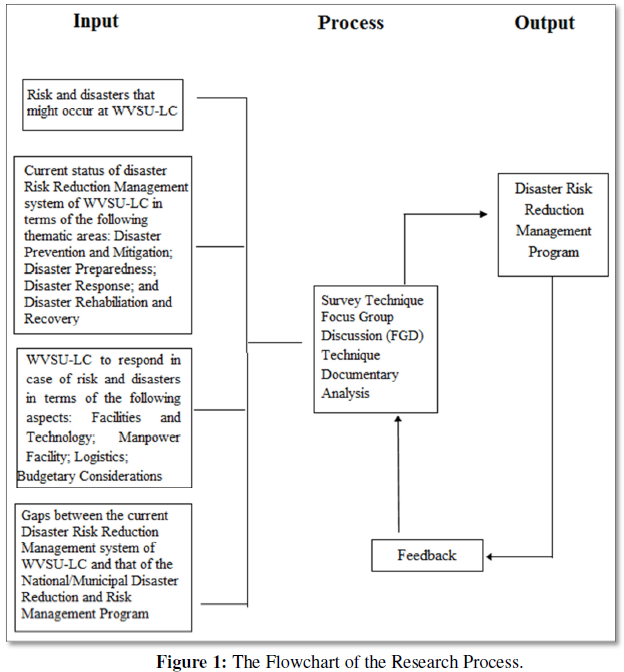

due to low voltage, power overload, unattended laboratory activities, flammable material, indiscriminate disposal of cigarette butts among others. The occurrence of fire causes possible damage to property and casualties due to absence of regular training and fire drills and mitigation and lack of preparedness and responsiveness.
As discussed during the focus group discussion, the risks from these disasters can be reduced if proper mitigation to lessen the vulnerability of the school from threat to damage and casualties. For instance, inspection of the buildings must be regularly made and the use of required standard materials is highly recommended.
Vulnerability has some distinct underlying causes. The magnitude of each disaster, measured in deaths, damage, or costs increases if mitigation was not imposed, and the spatial vulnerability which was emphasized by Fekete (2012). In this case the responses of the informants in the focus group support the arguments raised by Nierkerk (2011) that coping capacity for disaster risk reduction which refers to the ability of people, organisations and systems, using available skills and resources, to face and manage adverse conditions such as hazards, emergencies or disasters. The focus here should therefore not only be on the individual or the community but also the capacity of the supporting mechanisms to the individual and the community at large (Eiser, et al (2012).
In addition, Nierkerk (2011) is consistently following the RA 10121, that the NDRRMC has the responsibility to the MDRRMO, down to the school based risk and disaster reduction from which also in cognizant with the mandates of Memorandum Circular no. 4 series of 2012 or the creation of incident command system and response clusters wherein specifying the responsibilities of the NDRRMC on coordination, integration, supervision and monitoring the development and enforcement by agencies and organizations of the various laws, plans, programs, guidelines, codes, or technical standards required by this Act; managing and mobilizing resources for DRRM, including the National DRRM Fund; monitoring and providing the necessary guidelines and procedures on the Local DRRM Fund (LDRRMF) releases as well as the utilization, accounting, and auditing thereof.
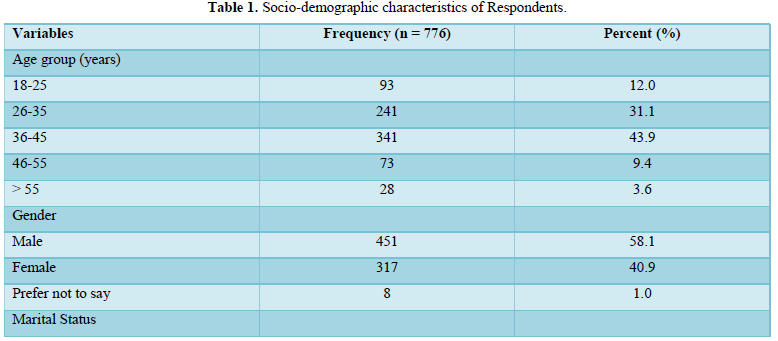

CURRENT STATUS OF DISASTER RISK REDUCTION MANAGEMENT SYSTEM
(Table 2) shows that majority of the respondents agreed that there is no disaster risk reduction system at WVSU-LC in terms of the following thematic areas: Disaster prevention and mitigation; disaster preparedness; disaster response; and disaster rehabilitation and recovery. This was revealed by the frequency results of f=79 or 96.4 percent out of 82 respondents.
These results conformed to the response raised by one of the informants from WVSU-LC during the focus group discussion that, “the school is still in the process of organizing the school-based disaster risk reduction management system at present”. Further, a respondent from the MDRRMO and BFP supported these arguments because as observed WVSU-LC still does not have the pre-disaster, during disaster, and post-disaster mitigation system making it vulnerable to possible threats caused by the multiple disasters that may occur in the future.
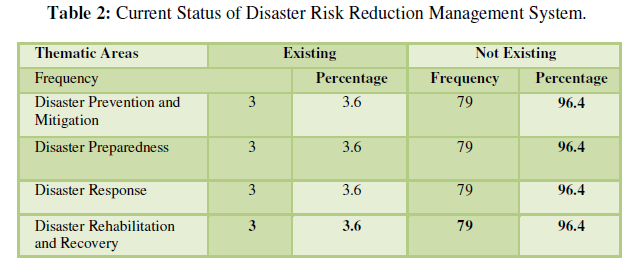
The level of capability of WVSU-LC to respond in case of risk and disasters in terms of the following aspects: Facilities and Technology; Manpower Facility; Logistics; Budgetary Considerations.

The level of capability of WVSU-LC to respond in case of risk and disasters in terms of the following aspects: Facilities and Technology; Manpower Facility; Logistics; Budgetary Considerations.
(Table 3) showed that WVSU-LC has “High” capability or potential to respond in case of risks and disasters in general and in terms of the identified variables. This was revealed by the mean score ratings which fell within the range of 2.51-3.50 scales.
The results were agreed by the respondents from WVSU-LC during the focus group discussion. Although WVSU-LC had just started creating the school-based risk and disaster reduction office, the school had already allocated a baseline budget for operation, and with the help of the experts from the MDRRMO the standards to comply with its requirements can be easily manifested.
The results and responses of the informants conformed that WVSU-LC has the potential to resolve issues on risk and disasters as pursuant to the school-based risk and disaster reduction Memorandum Circular 04, s. of 2012, that stated “all schools and colleges, public and private shall embed within their system the risk and disaster reduction program as mitigation in case of manmade and natural disasters.”


THE GAPS BETWEEN THE CURRENT DRRM SYSTEM OF WVSU-LC AND THAT OF THE NDRRMO/ MDRRMO
Experts from the MDRRMO clarified the three thematic areas to consider identifying the Risks and Disaster Reduction system gaps. These were on disaster prevention and mitigation (pre-disaster), disaster response (during disaster), rehabilitation (post- disaster). These gaps were summarized in (Table 4).
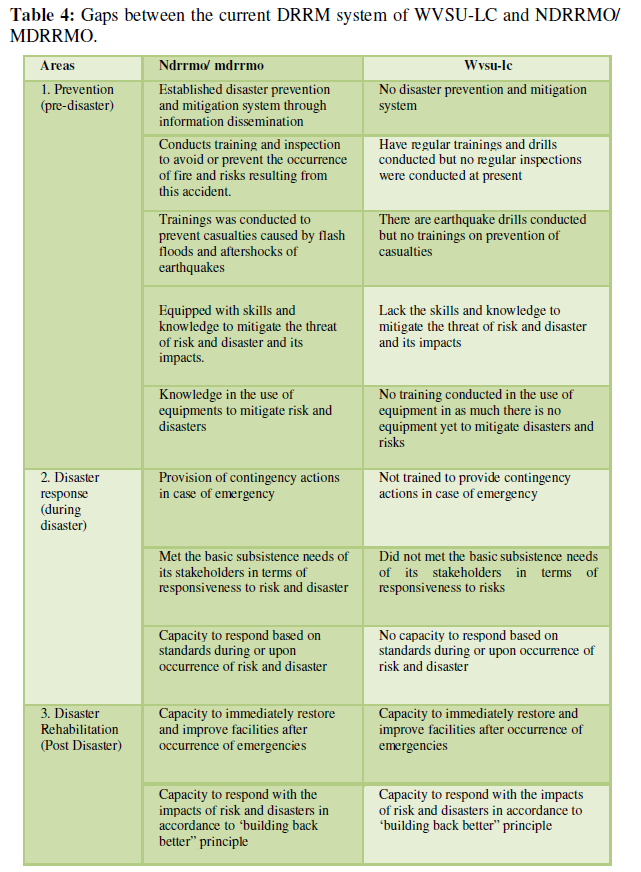

The results were validated by the responses of the informants during the focus group discussion. Informants were composed of the heads of the different units and schools of WVSU-LC, including the head of the newly created risk and disaster reduction management committee and students; the representatives from the Municipal Police Station, Municipal Fire Station, Department of Social Welfare and Development, and the Municipal Risk and Disaster Management Office. Responses were categorized according to different thematic areas based from focus group discussion guide questions and shown in (Table 5).
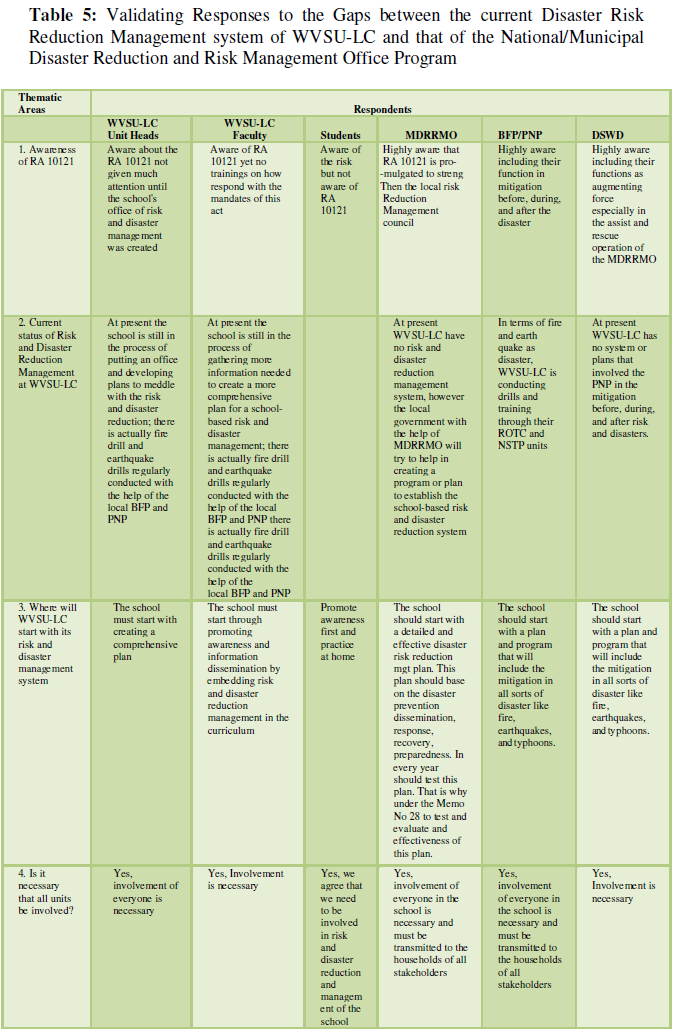

In Table 5, it was further revealed that the responses of the different informants is parallel with the mandates of the RA 10121 as stated in the NDRRM Plan 2011-2028 that lead agencies and implementing partners shall work together to identify specific programs and projects and pin down specific budgets to have better DRRM investments and synergy between government programs. According to the representative from the MDRRMO an important link in the national-local chain are the Regional Disaster Risk Reduction and Management Councils (RDRRMCs) and the Local DRRMCs. The RDRRMC shall take the overall lead in ensuring that DRRM-sensitive regional development plans contribute to and are aligned with the NDRRMP. Local DRRM Plans (LDRRMPs) which OCD (Office of the Civil Defense) is tasked to evaluate, shall ensure that DRR measures are incorporated into the Comprehensive Development Plan (CDP) and the Comprehensive Land Use Plan (CLUP) of the local government units. The LDRRMPs shall be developed by the Local DRRM Offices (LDRRMOs) at the provincial, city and municipal levels and the Barangay Development Councils. These offices shall play a critical role in attaining community resilience against disasters.
Likewise, as mandated by the Memorandum Circular no 28, series of 2012 to the Dep Ed (Department of Education and CHED (Commission on Higher Education) the schools have to comply with all the requirements to keep the safety of the pupils and students because this will reflect with the MDRRMO in case casualties occur in case of risk and disaster.
Consensus on responses of the informants was revealed on the issue of creating of a school based comprehensive risk and disaster reduction management plan. Whilst was reiterated by the MDRRMO representative that the plan must be programmed and will start with information dissemination and awareness promotion. Within the plan a program must be created to elaborate the series of activities for the implementation which was also suggested to start with the putting up of an office, and allocating budgets for the purchase of necessary equipment and training of persons that are involved in the program.
As added, to enhance the program, sub-committees must also organize such as Fire Team-equipment’s: Tools, Boots, Fire extinguishers, Helmet; First aid and Medical Team-medical Kit and other equipment; Security Team; Traffic Team; Communication team; Evacuation Team; Finance Team; and Planning Team for streamlining purposes.
In summary, the results and findings had come up with a Proposed School Based Disaster Risk Reduction Management Plan (SBDRRMP) for WVSU-LC) as the key output to this research endeavor.
CONCLUSIONS
It was concluded that WVSU-LC is vulnerable both to manmade and naturally occurring disasters which was prompted by social economic factors like population and geographical location. These risk and disaster are expected to cause casualties and damage to properties. The non-existence of risk and disaster reduction management system in terms of disaster prevention, disaster, preparedness, disaster responsiveness, and disaster rehabilitation at WVSU-LC added to the possibility of causing extreme hazards caused by disasters. Based from the results is was concluded that WVSU-LC has the potential to resolve the issues on risk and disaster reduction management. It seems that all the resources needed for mitigation before, during, and after disaster can be provided by the school more specifically on the aspect of man, money, machine, and methods.
The gaps in the areas of mitigation and implementation of risks and disaster reduction system between WVSU-LC and NDRRMO/MDRRMO added to vulnerability of the agency to damages cause by disasters. It seems that the faculty, the staff, and students of the school are not yet aware with the mandates of the NDRRMP of RA 10121. Apparently, it is a breakthrough towards the WVSU-LC community because a first ever research-based School Based Disaster Risk Reduction Management Plan has been ever formulated. Conclusively, this had offered an opportunity to the school and its stakeholders to expect a disaster and risk resilient environment that would put an end to the threats brought about by such.
- Aldrich, D.P. (2013). Response to my critics. Risk Hazard and Crisis in Public Policy 4(1), 32-43.
- Billing, P. & Madengruber, U. (2006). Overcoming the black hol outline for a quan titative model to compare coping capacities across countries. in J Birkmann Measuring Vulnerability to Natural Hazards Towards Disaster Resilient Societies TERI Pres Tokyo, 403-415.
- Birkmann, J. (2007). Risk and vulnerability indicators at different scales applic ability usefulness and policy implications. Environmental Hazards 7(1), 20-31.
- Birkmann, J., Cardona, O.D., Carreño, M.L., Barbat, A.H., Pelling, M., et.al., (2013). Framing vulnerability risk and societal responses the MOVE framework. Natural Hazards 67 (2), 193-211.
- Comerio, M.C. (2014). Disaster recovery and community renewal Housing approaches Cityscape. A Journal of Policy Development and Research 16(2), 51-68.
- Cutter, S.L., Mitchell, J.T., & Scott, M.S. (2000). Revealing the vulnerability of people and places a case study of Georgetown County South Carolina. Annals of the Association of American Geographers 90(4), 713-737.
- Dikmen, N. (2006). Relocation or rebuilding in the same area an important factor for decision making for post disaster housing projects. In International Conference and Student Competition on Post Disaster Reconstruction Meeting Stakeholder Interests. Florence Italy 17-19.
- Działek, J., Biernacki, W., & Bokwa, A., (2013). Challenges to social capacity building in flood-affected areas of southern Poland. Natural Hazards and Earth System Sciences 13(10), 2555-2566.
- Disaster Risk Reduction Resource Manual Safer Schools Resource Manual 2008. Department of Education Philippines Plan International Philippines.
- Doocy, S., Daniels, A., Murray, S., & Kirsch, T.D. (2013). The human impact of floods a historical review of events 1980-2009 and systematic literature review. PLOS Currents Disasters. Edition 1. Available online at: http://currents.plos.org/disasters/index.html%3Fp=6695.html
- Dorahy, M.J. & Dymand, L.K. (2012). Psychological distress following the Christchurch earthquake: a community assessment of two differentially affected suburbs. Journal of Loss and Trauma 17(3), 203-217.
- Eiser, J.R., Bostrom, A., Burton, I., Johnston, D.M., Mcclure, J., et.al., (2012). International Journal of Disaster Risk Reduction Risk interpretation and action. A conceptual framework for responses to natural hazards. International Journal of Disaster Risk Reduction 1, 5-16.
- Fekete, A. (2012). Spatial Disaster Vulnerability and Risk Assessment Challenges in their Quality and Acceptance. Natural Hazards 6(3), 1161-1178.
- Fekete, A., Damm, M., & Birkmann, J. (2010). Scales as a challenge for vulnerability assessment Natural Hazards 55(3), 729-747.
- Fekete, A., Hufschmidt, G., & Kruse, S. (2014). Benefits and Challenges of Resilience and Vulnerability for Disaster Risk Managemen. International Journal of Disaster Risk Science. 5(1), 3-20.
- Gjerde, M. (2017). Building Back Better Learning from the Christchurch Rebuild. Procedia Engineering 198, 530-540.
- Halhier, B. (2010). Focus Group as social enactments integrating interaction and content in the analysis of focus group discussion data. Sage Journals 10(1).
- Kenney, C.M. & Phibbs, S. (2014). Shakes rattles and roll outs: The untold story of Māori engagement with community recovers social resilience and urban sustainability in Christchurch New Zealand. In Proceedings of the 4th International Conference on Building Resilience. Procedia Economics and Finance.
- Higgins, M. (2010). Urban design and the planning system in Aotearoa New Zealand: Disjuncture or convergence. Urban Design International 15(1), 1-21.
- Myburgh, D., S. Wilkinson, & E. Seville, (2008). Post disaster reconstruction research in New Zealand an industry update. Resilient Organisations pp 36.
- National Disaster Risk Reduction and Management Plan (NDRRMP) 2011‐2028.
- Niekerk, D., (2011). Introductions to Disaster Risk Reduction. US Aid for International Development.
- Nili, A. (2017). A Framework and Approach for Analysis of Focus Group Data in Information Systems Research. Communications of the Association for information Systems 40(1).
- Parker, M. & Steenkamp, D. (2012). The economic impact of the Canterbury earthquakes. Reserve Bank of New Zealand Bulletin 75(3), 13-25.
- Paton, D., Sagala, S., Okado, N., Jang, L., Burgelt, P.T., et.al., (2010). Making sense of natural hazard mitigation personal social and cultural influences. Environmental Hazards 9, 183-96.
- Potter, S.H., Becker, J.S., Johnston, D.M., & Rossiter, K.P. (2015). International Journal of Disaster Risk Reduction An overview of the impacts of the 2010-2011 Canterbury earthquakes. International Journal of Disaster Risk Reduction 14, 6-14.
- Rufat, S., Tate, E., Burton, C. G., & Sayeed, A. (2015). Social vulnerability to floods: Review of case studies and implications for measurement. International Journal of Disaster Risk Reduction 14, 470-486.



